Recent Articles
Popular Makes
Body Types
2018 Lexus LC Road Test and Review
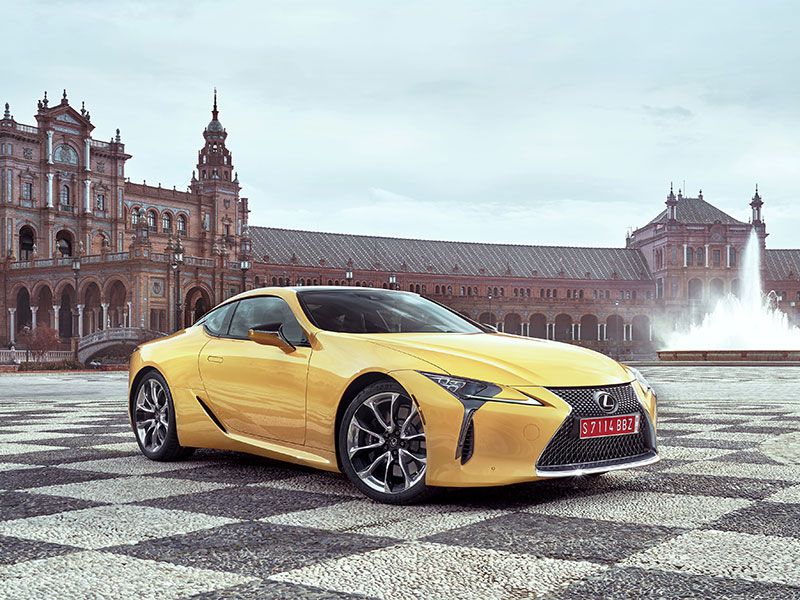
2018 Lexus LC 500 exterior front angle hero parked ・ Photo by Lexus
Success in the car industry is all about conquering new ground. It’s not enough to command the high ground in your segment. You have to look to the horizon, and figure out how to take the next hill, the one you can’t even see yet. The 2018 Lexus LC 500 and LC 500h are the vehicles it believes will take the company down the twists and turns toward the next summit—the one that has consumers viewing Toyota’s luxury arm as a serious driver’s brand. Like nearly every move that Lexus takes, the groundwork for the LC has been well established. The new performance coupe follows in the path of the F-labeled vehicles, the F-Sport packages, and, of course, the LFA supercar.
What is the LC?
The Lexus LC is a front-engine/rear-drive 2+2 coupe, built on Lexus’ all-new global vehicle architecture that will eventually underpin the next-generation LS sedan and other future vehicles. Initially, the LC will be offered in two variants: the LC 500, powered by a conventional naturally-aspirated gasoline V8 engine, and the LC 500h, powered by a multi-stage hybrid gasoline/electric system.
The 2018 Lexus LC falls into the general category of GT or Grand Touring vehicles. Traditionally, GT cars are luxury sports cars aimed more at long distance comfort than race course sharpness. Lexus named a few competitors, including the BMW 6 series, Mercedes-Benz S-Class Coupe, and Jaguar F-TYPE, even stretching to include the rear-engine Porsche 911. That’s a ritzy group, and it gives you some idea of how seriously Lexus is playing the game.
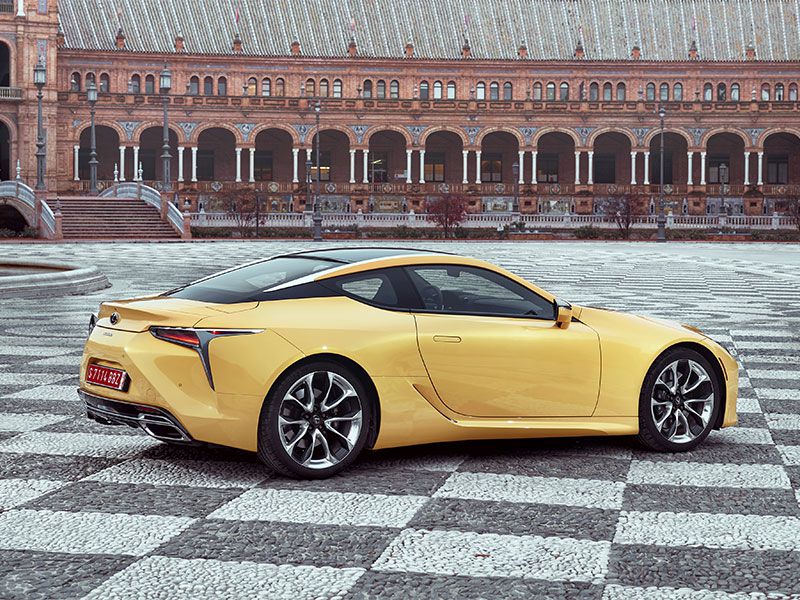
Photo by Lexus
Exterior Design
Before a GT coupe can impress you with its abilities, it must capture your eyes and your imagination. The LC does that immediately with an athletic, flowing design. The “spindle” grille has now populated the Lexus family from top to bottom, and finds its best expression on the LC’s low, wide front fascia. The long hood is impossibly low, falling away from the windshield toward the vehicle’s front. It is so low, in fact, that Lexus engineers had to invent a "pop-up-hood" mechanism to comply with pedestrian safety concerns. Long side doors lead to muscular haunches as the roof swoops to the rear in fastback style, though the trunk opens in notchback fashion. This is one of those vehicle designs that rewards you with great looks from multiple angles. Hybrid and gas-only versions differ only in subtle badging.
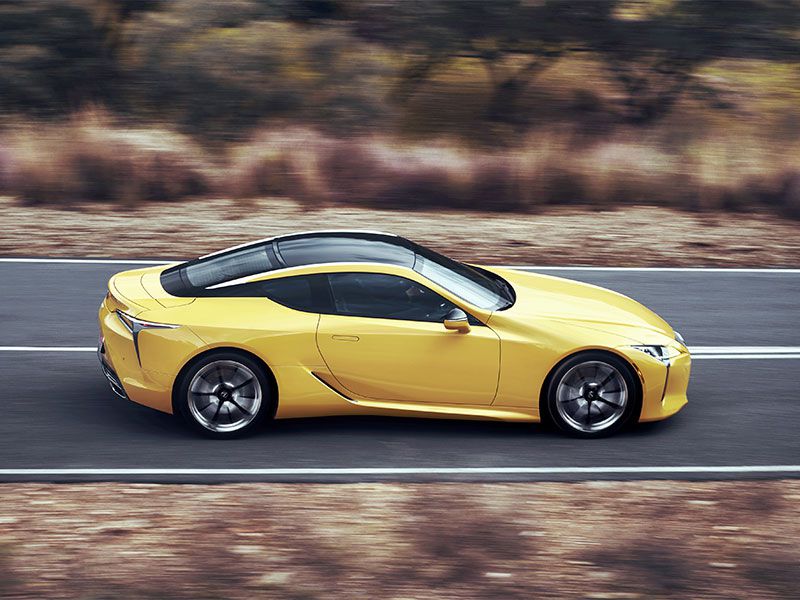
Photo by Lexus
Interior Design
Blast symmetry! The LC cants the controls toward the driver in cockpit style. This is definitely a driver’s car, though the passenger is treated to a luxurious, comfortable perch. The most striking feature of the interior is a layered dash, elegantly formed from a mix of high-quality materials, including hand-stitched leather. The passenger is provided with two comfortable, convenient hand grips, one designed into the door panel and one on the center console, both welcome during heavy cornering. The driver gets a design that lays out controls intuitively and smartly, with form following function in an elegant way. A wide 10.3-inch color navigation screen lives at the top of the center stack, tucked in below the dash, and an 8.3-inch thin transistor film (TFT) screen provides a customizable display in the instrument panel.
Column-mounted paddle shifters are found behind the steering wheel, and leather bucket seats are standard. Bolstered sport seats are available, but they're a bit narrow for full-size folks. The second row is vestigial; in this case, 2+2 means 2 people + 2 briefcases.
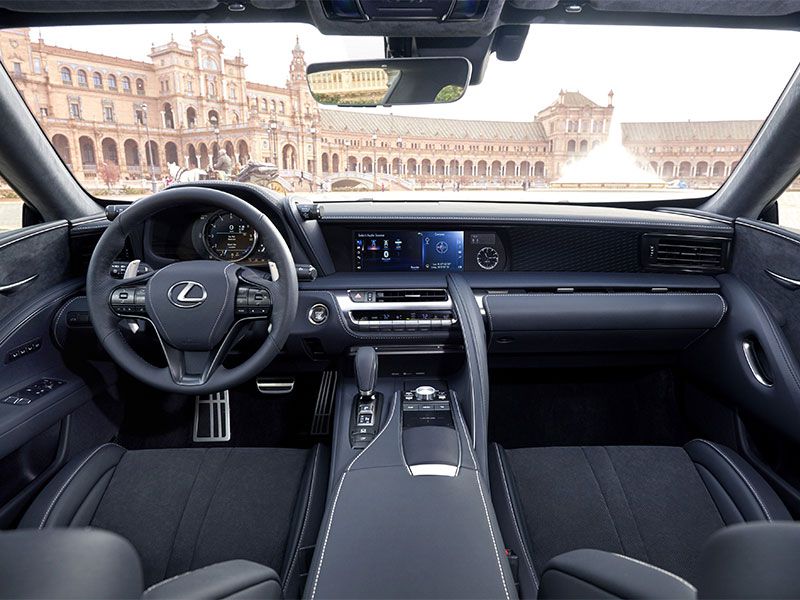
Photo by Lexus
Mighty 5-Liter V8
Though both the LC 500 and LC 500h share most of their exterior and interior designs, they differ greatly in engine choices and character. The 5.0-liter V8 in the LC 500 is the killer selection. This naturally aspirated engine employs double overhead cams, four valves per cylinder, variable valve timing, and direct injection to produce 471 peak horsepower and 398 lb.-ft. of torque with premium (91 octane) gasoline.
Lexus says the 4280-lb. LC 500 hits 60 mph in 4.4 seconds and has an electronically governed top speed of 168 mph—not supercar figures, but in line with the Grand Touring class. A quick-shifting 10-speed automatic transmission, specially developed for the LC 500, does a great job of keeping the engine humming. At a time when dual-clutch automatic transmissions (DCT) are in fashion, the new Sport Direct Shift is a traditional unit with much attention paid to the shifting rhythm. The resulting feel is progressive, forceful and natural, making the paddle shifters almost an afterthought, even in assertive driving situations.
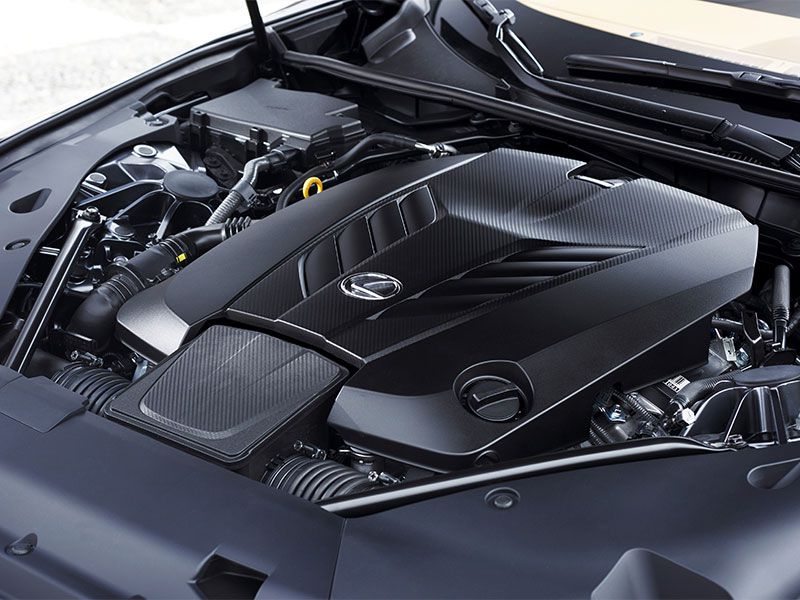
Photo by Lexus
Gasoline/Electric Hybrid
The hybrid gasoline/electric powertrain in the new Lexus LC 500h uses a 3.5-liter V6 gas engine and two electric motors. Unlike hybrid setups designed for maximum fuel efficiency, this setup eschews the Atkinson cycle for a multi-stage process where one motor serves as generator, engine starter and engine speed control, while the second motor drives the rear wheels and handles regenerative braking. The combination of engine and motors feels like a boost in operation, with the motor adding power to the engine in demand situations and delivering a total system output peak of 354 horsepower. Electricity is stored in lithium-ion battery cells, mounted low and toward the rear of the coupe.
Lexus says the LC 500h hits 60 mph in 4.7 seconds and has a limited top speed of 155 mph. A multi-stage HV transmission (a form of continuously variable automatic CVT) with four gear ratios provides smooth operation without the dreaded drone that can afflict some CVTs. Fuel economy estimates have not yet been announced for the LC 500h or the LC 500.
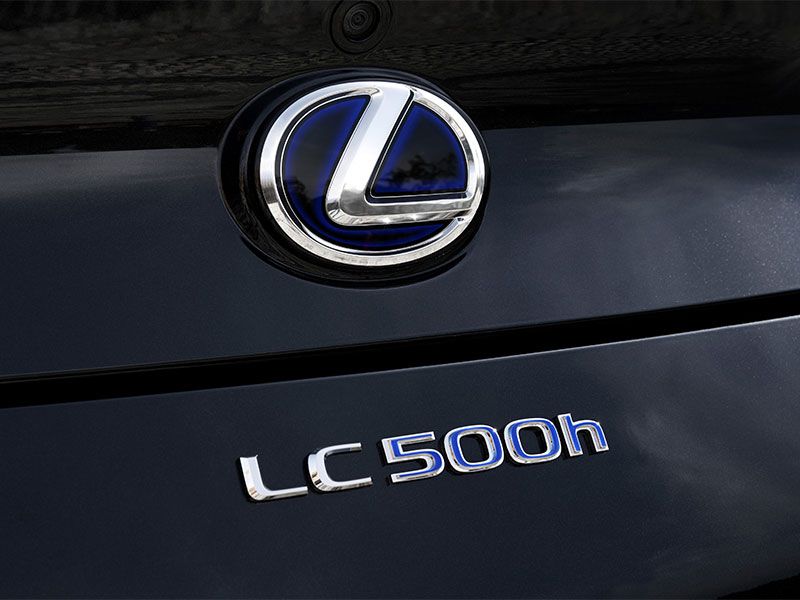
Photo by Lexus
Suspension, Steering, Handling, Braking
Both front and rear suspension units in the LC are multilink designs, carefully crafted for light weight, adjustability, and compliance. Although Lexus has a reputation for comfort over sharpness, the LC can swallow bumps and smooth the road in cruising mode while also providing crisp turn-in and precise stability during aggressive driving. Thanks to a very well tuned steering rack with speed-sensitive electric assist and excellent feel, the LC feels connected to the road. Also, the LC’s low center of gravity is always an asset when changing direction. The LC 500 V8 has great brakes, too; they're big units with ABS and a direct, linear pedal feel. The harder you brake, the quicker the LC stops, just like you expect. The hybrid’s regenerative braking system takes a little more familiarization, as the initial press on the pedal doesn’t have the bite that you hope for—it’s slowing you down, but also recapturing braking energy to recharge the battery. Press harder, and more braking comes on line, but it’s challenging to modulate. In high demand situations, the hybrid requires more braking distance.
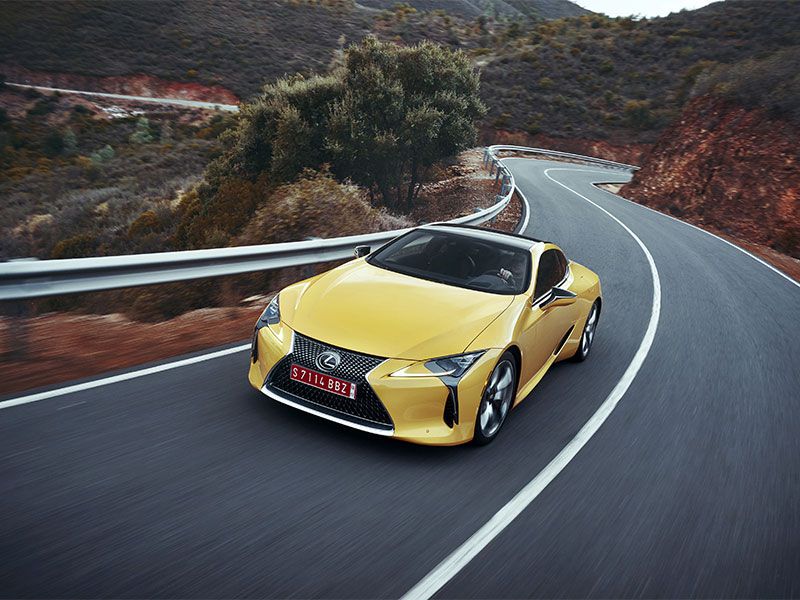
Photo by Lexus
On the Road
We were able to spend a few hours driving the LC 500 and LC 500h on a wide variety of public roads, including some very twsity ones, during the press launch. Sitting sports car low in an urban traffic jam is never much fun, but the LC handled it well with easy-to-modulate power and refined manners. Outward visibility could be a little better, especially to the rear, but blind-spot monitoring, a standard driver assistance feature, eased the journey. We also had the privilege of driving a few laps in each version of the LC on a closed racetrack, accompanied by a Lexus pro driver. While the LC is not designed or marketed as a track car, driving it toward its limits in a controlled situation made sense, as it amplified the coupe’s strengths—balance and precise handling.
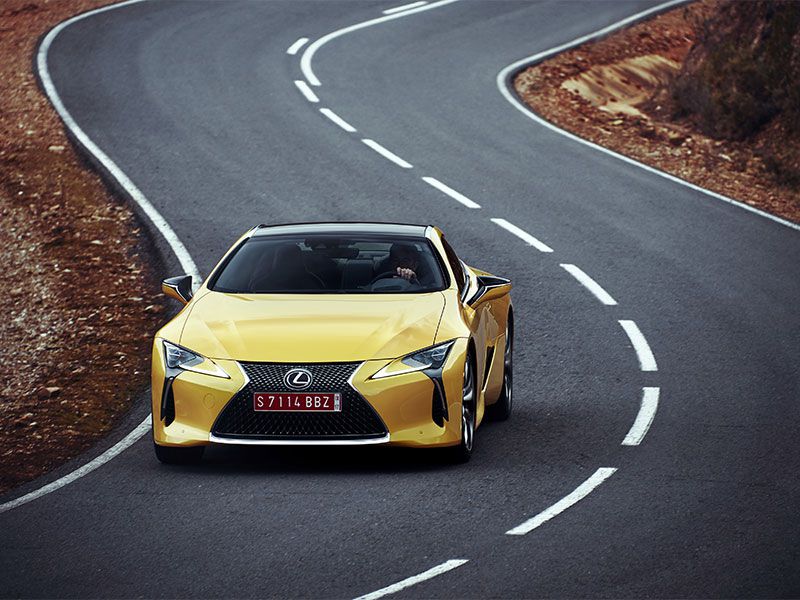
Photo by Lexus
Trim Levels, Pricing, Packages
Pricing has not been announced for the LC 500 or LC 500h, but Lexus promises it will land in the heart of the competitive set. That’s a broad price range—from the mid-$70,000s to about $120,000—but a base price of under six figures is likely. There will be lot of options available, including a carbon-fiber roof, sport seats, active rear steering, an active rear spoiler, and other goodies sure to thrill the enthusiasts. The open secret of an F-Sport version of the LC is still just a rumor, but it seems likely. We’re hoping for a higher horsepower version of the V8, maybe the result of tuning or even the addition of turbochargers or a supercharger. There’s room for more carbon-fiber pieces and aero kits, lighter wheels and other high end upgrades. The new platform will almost certainly support all-wheel drive when it underlies the LS, so there’s hope of an all-wheel drive LC in the future, too. How cool would that be?
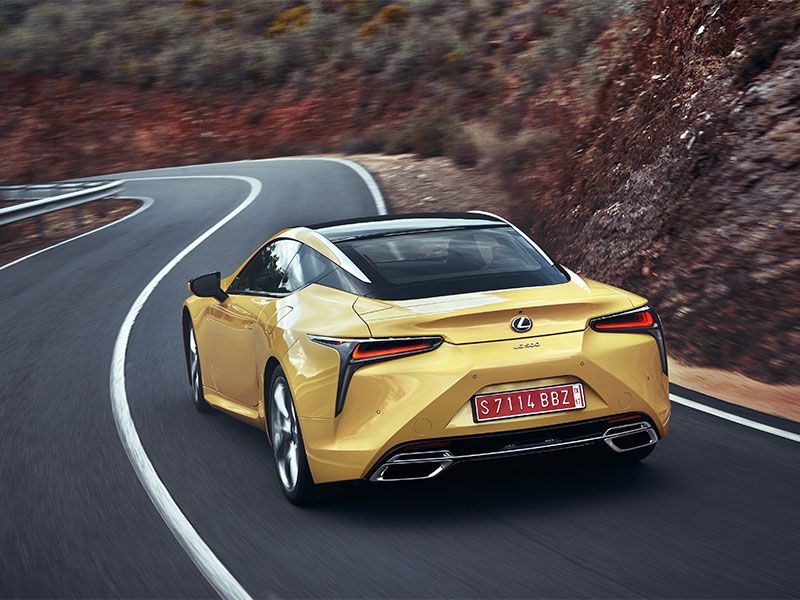
Photo by Lexus
Final Thoughts
Even though we don't know its price, it's tough to not to fall in love with a 2+2 GT coupe that does so much well, and has such beautiful style. With the new 2018 LC, Lexus has pointed the way toward its future without discarding the past. The LC has the traditional Lexus virtues—great engineering, comfort, luxury and solid build quality—while adding a significant dose of engagement that will attract well-heeled buyers who are serious about driving. If the price is right, the 2018 Lexus LC 500 will make a big impression.
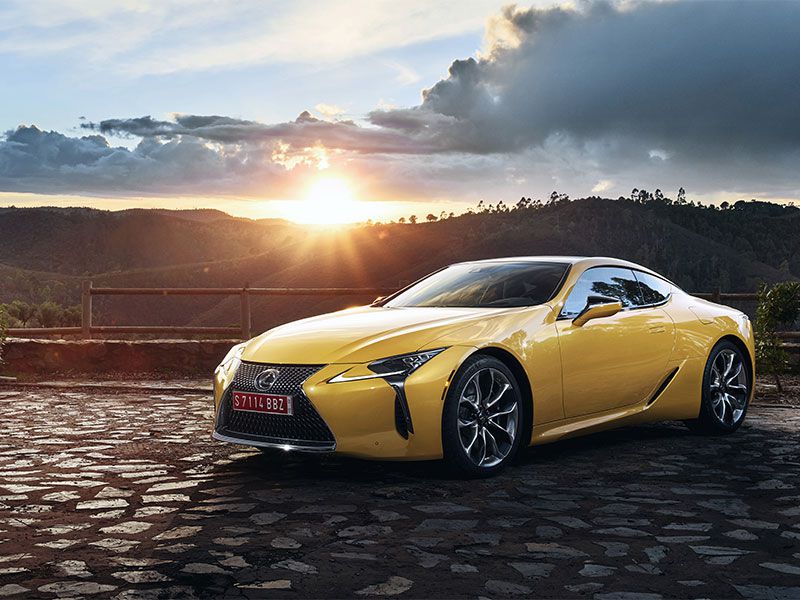
Photo by Lexus